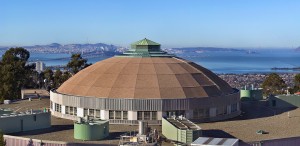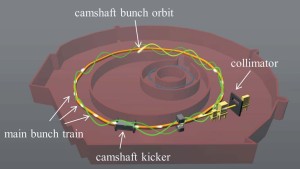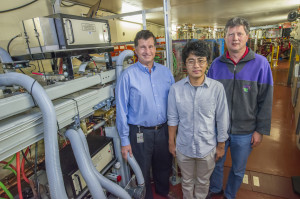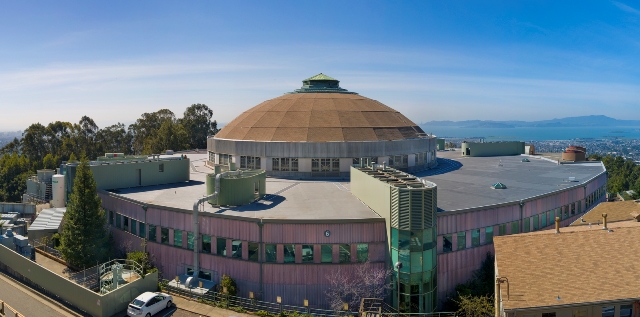
Berkeley Lab’s Advanced Light Source is an electron accelerator/storage ring that serves as a premier source of X-ray beams for scientific research ranging from advanced materials to protein crystallography and 3D biological imaging. (Photo by Roy Kaltschmidt)
Consumers are now in the era of “on-demand” entertainment, in which they have access to the books, music and movies they want thanks to the internet. Likewise, scientists who use synchrotron light sources are welcoming an era of “on-demand” X-rays, in which they have access to the light beams they want thanks to a technique developed at the U.S. Department of Energy (DOE)’s Lawrence Berkeley National Laboratory (Berkeley Lab).
Working at Berkeley Lab’s Advanced Light Source (ALS), a DOE Office of Science User Facility, researchers have created an operational mode for synchrotron light sources that provides full control of the timing and repetition rate of single X-ray pulses without affecting beams for other users. The mode, which is called “pseudo-single-bunch kick-and-cancel,” or PSB-KAC for short, works by displacing and routing a single electron bunch – dubbed the “camshaft bunch” – from the multi-bunch train of an electron beam in a synchrotron storage ring so that only X-ray light from this camshaft bunch reaches the experiment.
“With PSB-KAC, synchrotron light source users conducting stroboscopic experiments have full control over which of the X-ray pulses will arrive at their sample out of a pulse train that usually arrives at a fixed frequency of 500 megahertz,” says ALS beamline scientist Andreas Scholl. “PSB-KAC allows users to do timed experiments in which the X-ray pulses must be synchronized to a laser, detector, or some other device during normal light source operations because the X-ray pulse pattern can be dynamically controlled for their individual experiment.”

The PSB-KAC technique uses a kicker magnet in a synchrotron’s storage ring to displace the camshaft bunch from the multi-bunch train of electrons. A collimator only allows light from the camshaft bunch to reach the experiment.
Says David Robin, the ALS division deputy for Accelerator Operations and Development, “The on-demand X-rays provided by PSB-KAC greatly reduces radiation damage to samples while improving signal-to-noise and background ratios for sensitive measurements. Until now, the X-ray pulse train in synchrotron light sources has been static and limited by the design and operation of the storage ring. With PSB-KAC, synchrotron light source users can optimize their experimental set-up for single shot, kilo- or mega-hertz repetition rate pulses.”
Light sources have become the eyes of modern science, providing X-rays that enable researchers to study chemistry at its most basic levels. Synchrotron light sources, like the ALS at Berkeley Lab, accelerate electrons around a circular storage ring, boosting them to relativistic energies and then directing them through magnetic insertion devices that can be tailored to extract highly bright and intense beams of X-rays or other light. The accelerated electrons move through a synchrotron’s storage ring in a long train of short bunches. These multiple electron bunches can be made to generate X-ray light in pulsed beams of a fixed frequency. In the case of the ALS, the fixed frequency of its X-ray beams is 500 megahertz (MHz), with a temporal spacing between pulses of two nanoseconds.

(From left) David Robin, Changchun Sun and Andreas Scholl were part of a research team that developed an “X-rays on demand” technique at Berkeley Lab’s Advanced Light Source. (Photo by Roy Kaltschmidt)
“Time-gated studies, such as stroboscopic pump–probe or time-of-flight experiments often demand X-ray pulses with high peak power but low to medium repetition rates, ranging from a single shot to 1 MHz,” Robin says. “This is well below the natural repetition rate of synchrotron light sources.”
The PSB-KAC technique uses a kicker magnet in the synchrotron’s storage ring to displace the camshaft bunch from the multi-bunch train of electrons. A collimator in the experimental beamline of choice blocks light generated from the multi-bunch train and only allows light from the camshaft bunch to reach the experiment.
“Periodically exciting the kicker sends the camshaft bunch on an oscillating trajectory, while the multi-bunch train is not affected,” Scholl says. “By choosing the right kicker pulse pattern and storage ring lattice, the camshaft bunch can first be displaced to a different orbit and then kicked back to its original orbit within a few turns. This kick-and-cancel process can be repeated at user-selectable intervals, thus creating single X-ray pulses with adjustable repetition rates.”
At the ALS, Robin, Scholl and their collaborators are deploying the PSB-KAC kicker magnet near beamline 6.0.2, an undulator magnet beamline optimized for femto- and pico-second pump-probe spectroscopy and the study of chemical dynamics at material surfaces and interfaces. However, the displaced camshaft pulse from the PSB-KAC kicker magnet is accessible at all ALS beamlines. Given that PSB-KAC camshaft bunch substantially lowers the X-ray power on optics and samples, and reduces X-ray dose by many orders of magnitude, it can enable or improve experiments that would otherwise be difficult or impossible to carry out at the ALS.
“For example, many organic materials, such as polymers and bio-materials, are very sensitive to radiation damage that results in the breaking of carbon bonds during an experimental measurement,” Scholl says. “Managing the X-ray dose is very important to prevent radiation damage before a measurement is finished. Prior to PSB-KAC, timed experiments often used X-rays at a much higher repetition rate than needed for a given measurement, resulting in orders of magnitude higher dose than necessary. PSB-KAC allows us to do measurements with much better statistics since all X-rays that hit the sample arrive with the correct timing. Optics downstream of the aperture that isolates the PSB-KAC pulse is also exposed to much lower power, allowing us to build much less massive optics without heavy cooling. This can improve the performance of the optics and further reduce costs.”
PSB-KAC has been in use at the ALS for nearly a year and the response by users has been enthusiastic. Robin says the technique is applicable to other existing synchrotron light sources and should be advantageous for future light sources as well.
“We have demonstrated the use of PSB-KAC at the ALS in pump–probe measurements on spin crossover complexes, and in a warm dense matter demonstration experiment using a time-integrating single-shot streak camera,” Robin says. “I would not be surprised if other synchrotron light source facilities, including next generation storage rings, begin PSB-KAC operations in the near future.”
Scholl is the corresponding author and Robin one of the co-authors of a paper in the Journal of Synchrotron Radiation that describes the PSB-KAC technique in detail. The paper is titled
“X-rays only when you want them: optimized pump–probe experiments using pseudo-single bunch operation.” Other co-authors are Marcus Hertlein, Amy Cordones, Josh Lee, Kyle Engelhorn, Thornton Glover, Benjamin Barbrel, Changchun Sun, Christoph Steier and Gregory Portmann.
This research was funded by the DOE Office of Science.
Additional Information
For more about the Advanced Light Source go here
An animated movie of the PSB-KAC technique can be viewed here
# # #
Lawrence Berkeley National Laboratory addresses the world’s most urgent scientific challenges by advancing sustainable energy, protecting human health, creating new materials, and revealing the origin and fate of the universe. Founded in 1931, Berkeley Lab’s scientific expertise has been recognized with 13 Nobel prizes. The University of California manages Berkeley Lab for the U.S. Department of Energy’s Office of Science. For more, visit www.lbl.gov.
DOE’s Office of Science is the single largest supporter of basic research in the physical sciences in the United States, and is working to address some of the most pressing challenges of our time. For more information, please visit the Office of Science website at science.energy.gov/.
